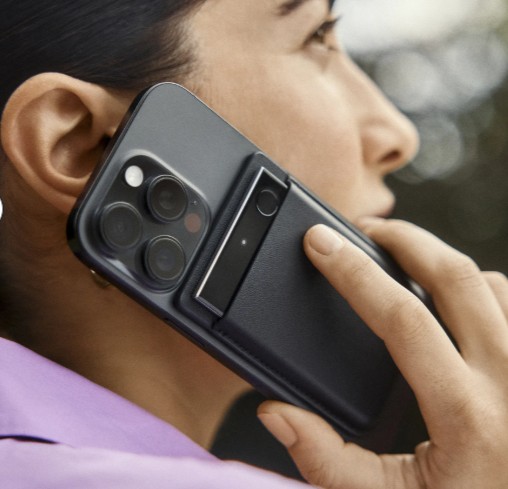Tech Features
Harnessing Technology in Hybrid Work Environments: Strategies for Success

By Professor Fiona Robson, Head of Edinburgh Business School and School of Social Sciences at Heriot-Watt University Dubai
For many, working in a hybrid model of some working from home and some from organisational premises is seen as a positive scenario. However, it can also be a double-edged sword in terms of blurring the boundaries. Advantages include flexible working options and may open up a new pool of candidates who don’t want to or aren’t able to travel every day. The benefits of hybrid include the cost implications of not having to travel twice a day and not losing productive time when travelling. Not every role would be suitable for hybrid working, for example someone working in customer services or providing a service in the homes of clients. Offering hybrid working options gives the potential to increase employee retention by meeting their needs. It is also important to recognize that hybrid working shouldn’t be perceived as a part time role with part time organizational commitment. Leaders are responsible for developing a culture whereby all eligible employees are encouraged to work remotely for at least some of their working time.
There is research which suggests that employees who are able to work from home are more productive than in the office. This makes assumptions that a) employees don’t mind the blurring of boundaries with their home life b) that they will have appropriate space from which they can work and c) that appropriate technology and infrastructure (e.g. wifi) is available. Depending on the home situation, there may be more distractions when working away from the office if it shared with other people. Ultimately the decision around moving to hybrid working will need the leader to consult and then take all the factors into account to establish the potential impact.
Technology can be used to improve performance throughout an organisation, for it to be successful there are a range of factors which need to be in place. Firstly, selecting the correct technology that can meet the needs of the organisations and their users. Once selected, extensive learning and development support is needed so that users feel confident and competent in using it for their roles. If there is equipment or software which isn’t used regularly, some reminders and an offer of training may be useful. The health and safety of hybrid workers should be considered, ensuring that remote working is organised and carried out in a safe way as part of the leader’s duty of care.
Technology is a good alternative where it isn’t possible for the leader to meet with all their employees. Software such as Teams and Zoom allow information to be shared instantaneously. Whilst there may be specific occasions where in-person is needed, many meetings can be online. Probably the biggest impact of the pandemic was how organisations had to pivot to be able to work remotely. For some employees, this was seen as a very good thing; having previously been told that it wasn’t possible for some roles, it was established that it could work. Hybrid working can also give time flexibility which may make international collaborations easier. Leaders should lead by example and highlight their own hybrid working, ensuring they have maximum visibility.
Potential disadvantages of hybrid working include having a negative impact on team-working and morale which leaders may need to address. Opportunities for valuable ‘water cooler’ conversations are likely to take place less frequently might lead to missed chances for collaboration or process improvement.
Hybrid/remote working does not mean that all networking opportunities are lost; technology now gives us many ways to achieve this – again, learning lessons from the pandemic where many conferences and events were delivered wholly online. Platforms such as LinkedIn allow leaders to connect to people across the globe and build their digital network. Other specialist software encourages leaders and their employees to have some informal online ‘coffee break’ time.
As a leader, a key decision is the extent to which employee performance should be monitored. Technology is available to do this; however, it raises an issue of trust. There may be certain occupations where it is necessary for the organisation to have access to this data for security reasons. Data protection and privacy policies should be adhered to at all times.
Strong leaders recognise the importance of giving and receiving feedback and for this to be built into project plans rather than just at the end of the activity. Where hybrid working means fewer opportunities for face-to-face engagement, technology can be used via software that collects and stores employee feedback. Leaders need to role model good behaviour by visibly seeking and responding to feedback on their own performance.
As a leader it is important that the HR team are briefed to reflect the organisation’s commitment to hybrid working by ensuring that policies and practices do not disadvantage hybrid workers. For example, reviewing internal promotion and performance review criteria to ensure they are appropriate. Updated IT policies should be considered, to reflect the needs of people who work at home and use secure data which would previously not have been available. Leaders should consider some of the sensitive issues around hybrid working, for example does it lead to the introduction of hot-desking. For some of their followers losing the artefact of their own personal space could be negative.
The use of AI in most organisations is still at a relatively early stage where many are only confident to dip their toes into the water. Where women leaders become early adopters of AI this can have a positive impact on the whole organisation. It also potentially provides the leaders themselves with a competitive advantage. Being upfront about the advantages and disadvantages will be useful as well as identifying where and when it might be used. The early inclusion of employees to influence the scope and implementation of AI is a worthwhile investment.
Many organisations collect data on a daily basis but don’t make the best use of it, and this is a missed opportunity. Leaders should invest in new hires who are experts in data analytics and can provide some bespoke use of technology to meet the specific needs of the organization. Importantly these appointments can upskill the existing workforce by learning in ‘real play’ rather than role play.
Whilst AI could lead to some disruption, sometimes that in itself encourages more innovation. Leaders have an ethical responsibility as well as a management one to ensure that AI is used appropriately and in compliance with regulations. Possibly the strongest opportunity at this stage for the use of AI to really make a difference, is collecting data on employee engagement on a continuous basis. This can be used to predict future behaviours and actions for the leadership team.
Leaders can use technology, for example, as part of their recruitment and selection processes so prospective candidates get a personalised experience. Personalisation could also be used as part of an employee engagement strategy. The use of AI isn’t a magic cure, and there will still need to be human interventions, particularly in the early adoption stages, to ensure fair decision-making.
Leaders’ HR teams will have to work with the experts to ensure that any potential negative outcomes of AI can be minimised e.g. if employees all start using Chat GPT for their work. Leaders will need their skills in managing change progress for an organisation that may find change very challenging.
Tech Features
FROM AI EXPERIMENTS TO EVERYDAY IMPACT: FIXING THE LAST-MILE PROBLEM

By Aashay Tattu, Senior AI Automation Engineer, IT Max Global
Over the last quarter, we’ve heard a version of the same question in nearly every client check-in: “Which AI use cases have actually made it into day-to-day operations?”
We’ve built strong pilots, including copilots in CRM and automations in the contact centre, but the hard part is making them survive change control, monitoring, access rules, and Monday morning volume.
The ‘last mile’ problem: why POCs don’t become products
The pattern is familiar: we pilot something promising, a few teams try it, and then everyone quietly slides back to the old workflow because the pilot never becomes the default.
Example 1:
We recently rolled out a pilot of an AI knowledge bot in Teams for a global client’s support organisation. During the demo, it answered policy questions and ‘how-to’ queries in seconds, pulling from SharePoint and internal wikis. In the first few months of limited production use, some teams adopted it enthusiastically and saw fewer repetitive tickets, but we quickly hit the realities of scale: no clear ownership for keeping content current, inconsistent access permissions across sites, and a compliance team that wanted tighter control over which sources the bot could search. The bot is now a trusted helper for a subset of curated content, yet the dream of a single, always-up-to-date ‘brain’ for the whole organisation remains just out of reach.
Example 2:
For a consumer brand, we built a web-based customer avatar that could greet visitors, answer FAQs, and guide them through product selection. Marketing loved the early prototypes because the avatar matched the brand perfectly and was demonstrated beautifully at the launch event. It now runs live on selected campaign pages and handles simple pre-purchase questions. However, moving it beyond a campaign means connecting to live stock and product data, keeping product answers in sync with the latest fact sheets, and baking consent into the journey (not bolting it on after). For now, the avatar is a real, working touchpoint, but still more of a branded experience than the always-on front line for customer service that the original deck imagined.
This is the ‘last mile’ problem of AI: the hard part isn’t intelligence – it’s operations. Identity and permissions, integration, content ownership, and the discipline to run the thing under a service-level agreement (SLA) are what decide whether a pilot becomes normal work. Real impact only happens when we deliberately weave AI into how we already deliver infrastructure, platforms and business apps.
That means:
- Embed AI where work happens, such as in ticketing, CRM, or Teams, and not in experimental side portals. This includes inside the tools that engineers, agents and salespeople use every day.
- Govern the sources of truth. Decide which data counts as the source of truth, who maintains it, and how we manage permissions across wikis, CRM and telemetry.
- Operate it like a core platform. It should be subject to the same expectations, such as security review, monitoring, resilience, and SLA, as core platforms.
- Close the loop by defining what engineers, service desk agents or salespeople do with AI outputs, how they override them, and how to capture feedback into our processes.
This less glamorous work is where the real value lies: turning a great demo into a dependable part of a project. It becomes a cross-functional effort, not an isolated AI project. That’s the shift we need to make; from “let’s try something cool with AI” to “let’s design and run a better end-to-end service, with AI as one of the components.”
From demos to dependable services
A simple sanity check for any AI idea is: would it survive a Monday morning? This means a full queue, escalations flying, permissions not lining up, and the business demanding an answer now. That’s the gap the stories above keep pointing to. AI usually doesn’t fall over because the model is ‘bad’. It falls over because it never becomes normal work, or in other words, something we can run at 2am, support under an SLA, and stand behind in an audit.
If we want AI work to become dependable (and billable), we should treat it like any other production service from day one: name an owner, lock the sources, define the fallback, and agree how we’ll measure success.
- Start with a real service problem, not a cool feature. Tie it to an SLA, a workflow step, or a customer journey moment.
- Design the last mile early. Where will it live? Is it in ticketing, CRM, Teams, or a portal? What data is it allowed to touch? What’s the fallback when it’s wrong?
- Make ownership explicit. Who owns the content, the integrations, and the change control after the pilot glow wears off?
- Build it with the people who’ll run it. Managed services, infra/PaaS, CRM/Power Platform, and security in the same conversation early – because production is where all the hidden requirements show up.
When we do these consistently, AI ideas stop living as side demos and start showing up as quiet improvements inside the services people already rely on – reliable, supportable, and actually used.
Tech Features
WHY LEADERSHIP MUST EVOLVE TO THRIVE IN AN AI DRIVEN WORLD

By Sanjay Raghunath, Chairman and Managing Director of Centena Group
Leadership today is being reshaped not by technology alone, but by the pace at which the world around us is changing. Conventional leadership models built on rigid hierarchies, authority, and control are no longer sufficient in an era defined by artificial intelligence, automation, and constant disruption. What organisations need now is a more human-centric model, adaptive, and grounded form of leadership.
As digital transformation accelerates, the role of a leader has fundamentally shifted from imposing authority. Leadership is no longer about issuing directions from the top; it is about guiding organisations and people through uncertainty with clarity and confidence. In an AI-driven world, effectiveness does not come from being the most technical person in the room, but from understanding how technology reshapes industries and how to integrate it responsibly to create long-term value.
The economic impact of AI is already undeniable. Reports suggest that AI could contribute up to USD 320 billion to the Middle East’s GDP by 2030, with the UAE alone expected to see an impact of nearly 14 per cent of GDPby that time. Globally,PwC estimates that AI adoption could increase global GDP by up to 15 per cent by 2035. These numbers signal more than opportunity, they signal inevitability. Leaders who cling to static models and resist change risk being overtaken as industries evolve around them.
One of the most persistent challenges in leadership today is resistance to change. When leaders rely on outdated hierarchies and familiar ways of working, organisations struggle to respond to volatility. What worked yesterday may no longer work tomorrow. Flexibility, once considered a desirable trait, has become a necessity for survival. Ignoring change is no longer an option.
At the same time, expectations of our colleagues have shifted significantly. People today seek more than compensation or career progression. They are looking for purpose, belonging, and leaders who communicate with transparency rather than authority. This shift is reinforced by the 2025 Employee Experience Trends Report, which draws on feedback from 169,000 employees. The findings show that belonging and purpose are now among the strongest drivers of engagement, while AI-related anxiety and change fatigue are growing concerns within the workforce.
These factors highlight the role of authentic human connection in leadership. One of the critical elements in this regard is emotional intelligence (EQ), which enables leaders to build trust, inspire confidence and form meaningful relationships with their teams. While data, analytics, and AI can inform better decisions, it is empathy that sustains relationships and credibility. Leaders who lack emotional awareness often appear distant, making trust difficult to establish and sustain.
In an era of advanced technologies such as AI, automation and chatbots, there is a prevailing fear about technology overtaking the human role. It is the leadership’s responsibility to instil confidence in people that technologies are designed to enhance human capability, not to diminish it. Technology must be positioned as an enabler. Even though the pace of this transformation can be exhausting, leaders must navigate this challenge with renewed energy and a clear strategy to guide their organisations.
Today, leadership that is adaptable, collaborative, and emotionally aware is proving far more effective than traditional command-and-control models. The transition is from exercising authority to creating genuine connections. Strong leaders integrate change into their strategies while keeping people at the centre of their organisations, while viewing technological innovations as a partner rather than a threat.
Investing in people is not optional, as roles continue to evolve and skill requirements change. Our colleagues must feel valued and supported, as recognition and empathy contribute to boosting engagement and innovation. Empathic leadership helps bridge the gap between market demands and individual needs. Listening with intent, understanding context and responding with genuine concern are no longer additional qualities, they are essential leadership competencies.
The future belongs to leaders who blend clear thinking with empathy, who remain grounded in the present while envisioning bold possibilities and driving innovation forward without eroding trust. In this AI-driven age, success depends on how leaders balance innovation with trust. Leadership is neither about resisting change nor surrendering to it entirely. It is the ability to guide people through uncertainty with emotional depth and stability, recognising that true authority is not earned through control, but through the strength of human connection.
Cover Story
PLAUD Note Pro: This Tiny AI Recorder Might Be the Smartest Life Upgrade You Make!

By Srijith KN
I’ve been using the Plaud Note Pro for over three months now, and this is a device that has quietly earned a permanent place in my daily life now. Let me walk you through what it does—and why I say that so?
Well at first I thought this wasn’t going to do much with my life, and by the looks of it Plaud Note Pro looks like a tiny, card-sized gadget—minimal, unobtrusive to carry it around.
With a single press of the top button, it starts recording meetings, classes, interviews, or discussions. Once you end your session, the audio is seamlessly transferred to the Plaud app on your phone, where it’s transformed into structured outputs—summaries, action lists, mind maps, and more.

In essence, it’s a capture device that takes care of one part of your work so you can concentrate on the bigger game.
Design-wise, the device feels premium, it features a small display that shows battery level, recording status, and transfer progress—just enough information without distraction. The ripple-textured finish looks elegant and feels solid, paired with a clean, responsive button. It also comes with a magnetic case that snaps securely onto the back of your phone, sitting flush and tight, making it easy to carry around without thinking twice.
Battery life is another standout. On a full charge, the Plaud Note Pro can last up to 60 days, even with frequent, long recording sessions. Charging anxiety simply doesn’t exist here.
Well, my impressions about the device changed once I had an audio captured. I tested this in a busy press conference setting—eight to ten journalists around me, multiple voices, ambient noise—and the recording came out sharp and clear. Thanks to its four-microphone array, it captures voices clearly from up to four to five meters away, isolating speech with precision and keeping voices naturally forward. This directly translates into cleaner transcripts. It supports 120 languages, and yes, I even tested transcription into Malayalam—it worked remarkably well, condensed the entire convo-interview that I had during an automotive racing show that I was into.
Real meetings or interviews are rarely happens in a neat environment, and that’s where I found the Plaud Note Pro working for me. It captures nuances and details I often miss in the moment. As a journalist, that’s invaluable. The app also allows you to add photos during recordings, enriching your notes with context and visuals.
I tested transferring files over 20 minutes long, and the process was smooth and quick. Accessing the recordings on my PC via the browser was equally intuitive—everything is easy to navigate and well laid out.

Now to what is inside this tiny recorder. Well, the core of the experience is Plaud Intelligence, the AI engine powering all Plaud note-takers. It dynamically routes tasks across OpenAI, Anthropic, and Google’s latest LLMs to deliver professional-grade results. With over 3,000 templates, AI Suggestions, and features like Ask Plaud, the system turns raw conversations into organized, searchable, and actionable insights. These capabilities are available across the Plaud App (iOS and Android) and Plaud Web.
Privacy is what I happen to see them look at seriously. All data is protected under strict compliance standards, including SOC 2, HIPAA, GDPR, and EN18031, ensuring enterprise-grade security.
What makes the AI experience truly effective is the quality of input. Unlike a phone recorder—where notifications, distractions, and inconsistent mic pickup interfere—the Plaud Note Pro does one job and does it exceptionally well. It records cleanly, consistently, and without interruption, delivering what is easily one of the smoothest recording and transcription experiences I’ve used so far.
I’m genuinely curious to see how Plaud evolves this product further. If this is where they are today, the next version should be very interesting indeed.
“The Plaud Note Pro isn’t just a recorder; it’s a pocket-sized thinking partner that captures the details so you can think bigger, clearer, and faster.”
- Plaud Note Pro is now available for pre-order at https://uae.plaud.ai/pages/plaud-note-pro
- Plaud Note and NotePin are available at https://uae.plaud.ai
-

 Tech News2 years ago
Tech News2 years agoDenodo Bolsters Executive Team by Hiring Christophe Culine as its Chief Revenue Officer
-

 VAR9 months ago
VAR9 months agoMicrosoft Launches New Surface Copilot+ PCs for Business
-

 Tech Interviews2 years ago
Tech Interviews2 years agoNavigating the Cybersecurity Landscape in Hybrid Work Environments
-

 Tech News6 months ago
Tech News6 months agoNothing Launches flagship Nothing Phone (3) and Headphone (1) in theme with the Iconic Museum of the Future in Dubai
-
News10 years ago
SENDQUICK (TALARIAX) INTRODUCES SQOOPE – THE BREAKTHROUGH IN MOBILE MESSAGING
-

 Tech News2 years ago
Tech News2 years agoBrighton College Abu Dhabi and Brighton College Al Ain Donate 954 IT Devices in Support of ‘Donate Your Own Device’ Campaign
-

 VAR1 year ago
VAR1 year agoSamsung Galaxy Z Fold6 vs Google Pixel 9 Pro Fold: Clash Of The Folding Phenoms
-

 Editorial1 year ago
Editorial1 year agoCelebrating UAE National Day: A Legacy of Leadership and Technological Innovation











